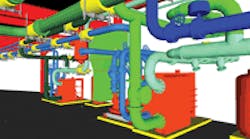For mechanical contractors involved in large, complex projects, the world is no longer flat. Three-dimensional (3D) CAD is enabling firms to win contracts and navigate these projects as never before — minimizing or eliminating potential clashes with other trades before getting into the field and developing cost-effective prefabrication and installation strategies.
Stoughton, Mass.-based mechanical contractor J.C. Higgins has a six-station CAD department, each furnished with the latest state-of-the-art technology, which includes an 850 Mz Pentium III processor and 384 MB of RAM. In 3D coordination work, CAD personnel are using AutoCAD 2006, MicroStation and Corel Flow and third-party software such as QuickPen Pipe Designer 3D and Navis Works Jetstream. Jetstream is a valuable design review tool that enables a contractor to perform a clash check with other trades and a take a virtual walk-through of the building.
Working in AutoCAD 2006 and QuickPen, three monitors are used: one showing the plan view layout, a second showing the isometric view and the third showing the elevation view. Plotting capabilities have been upgraded to include an HP1050C plotter as well as an HP750C, HP650C and HP450C. We use Lotus, Microsoft Office, FTP (File Transfer Protocol) Sites and E-Room software to transfer and share electronic files with the other members of the project team over the Internet.
The majority of our CAD experts have significant field experience installing the systems they draw, giving them first-hand knowledge of the challenges and needs of the field teams as well as a strong background in the coordination process.
Using 3D capabilities
Using this technology as either a lead contractor or member of the project team, CAD staff members initiate or follow the CAD standards dictated by the particular project. Coordination tasks are routinely performed, such as compiling composite drawings using write blocks or external references and downloading and adding manufacturers’ equipment cut sheets. Combining Lotus and AutoCAD enables the staff to embed the valve tag list into an as-built drawing for easy reference. In addition, our HVAC and plumbing coordinators are located within the same department to enable efficient mechanical system coordination.
The process works as follows. The 2D architectural and structural drawings are downloaded from the project’s FTP Site, which typically is maintained by the general contractor. From the 2D drawings, 3D structural drawings are created. We create and apply the HVAC sheet metal and then the HVAC piping and equipment. The composite drawings are then uploaded to the FTP Site. In turn, the plumbing contractor and fire protection contractor apply and upload their 3D drawings.
Typically, we perform the clash detection for the team because of our extensive experience and Navis Works capabilities. Following coordination meetings to eliminate those clashes, the drawings are revised as necessary. Each discipline then cuts its own fabrication drawings for review by the engineer.
Benefits of working in 3D
The ability to perform clash checks is a key benefit of working in 3D and, in particular, using the Navis Works software. With this capability we can identify any clashes between steel, pipe, ductwork, etc., providing locations and pictures for review in project team coordination meetings; we work together to eliminate those clashes. Performing clash checks enables us to save significant time and money, avoiding timely schedule delays, unnecessary re-coordination of labor and associated costs of solving these problems in the field.
In our experience, Navis Works fully enables a contractor to take 3D CAD “to the third dimension” — with clash detection and virtual walk-throughs of the building. This capability is being used to reduce clashes to zero. Yet, Navis Works is relatively user-friendly and can be learned on the job by someone who is experienced with AutoCAD.
Another benefit of the system is Pipe Designer’s comprehensive 3D library, from which we can extract fabrication sheets and a bill of materials, which can be exported into Microsoft Excel. This allows us to identify long-lead items, ensuring they are ready for delivery in a timely fashion. As the fabrication job progresses and materials are used, the system will deduct these items from the main list of bulk materials. Working in the 2D world would require a manual take-off from the coordination drawings. In addition, we are able to cut elevation views simply by turning the camera in the 3D view.
A case in point
In July 2006, J.C. Higgins Corp. was awarded a contract to install the shell and core HVAC mechanical work for The Center for Life Sciences building at the Black Fan Research Center, a $350 million facility in Boston. Located in the Longwood Medical area, the Black Fan Research Center is adjacent to and surrounded by Harvard Medical School Research Center, Merck Pharmaceuticals, Children’s Hospital and Beth Israel Hospital.
The new Center for Life Sciences is an 18-story building with approximately 1.1 million sq. ft. of space, including six stories of underground parking and 18 stories of tenant space for future fit-out as research, lab and administrative space for pharmaceutical and medical research organizations. The building comprises underground parking levels P1-P6; tower floors 1–12 of tenant space with mechanical rooms M-1/M-2; floors 12–18 of tenant space; and a penthouse level/roof housing mechanical equipment.
The project required installation of 6,600 tons of cooling capacity, 8.5 miles of piping and 12 custom-built air-handling units, totaling more than 1.1 million CFM of air. Careful coordination was required on the site, which has a tremendous amount of existing utilities that serve a variety of buildings, including steam and chilled water fed from the medical area total energy plant. To prevent disruption of services, a complex installation plan was developed that involved intricately phased construction and detailed transportation scheduling for the rigging and HVAC equipment. The result was an effective construction process on the heavily congested work site.
The project required mechanical piping 24/7 and hot tapping on 16-in. and 20-in. chilled water lines to systems in operation, a very difficult and dangerous procedure that required X-ray welding and inspection. Additionally, installers have had to use hot tapping to install mechanical piping into existing chilled water lines that remain in operation.
Our 3D CAD capabilities have helped with design, coordination and phasing. Here are just a few examples out of many.
Two potential problems were identified involving the generator breaching on the mechanical level: the breaching was hitting truss plates and interfering with the adjacent switchgear room, which was adjacent to the breaching. During coordination meetings, it was decided to relocate the switchgear to avoid the breaching. In turn, that allowed us to move the breaching away from the truss plates. Without 3D capability, it would be unlikely that these types of potential problems could be identified until installers were actually performing the installation.
In fact, there are always many potential clashes. For example, we probably started out with 70-80 clashes with the fire protection system, and that was reduced to zero.
In the mechanical rooms, HVAC equipment was restricted to a particular footprint to allow for future build-out of the mechanical systems as the building expands. Using 3D CAD provided the opportunity to try several different layouts and identify the one that would work best within that footprint. It enabled us to figure out the logistics of rigging the equipment into the building.
A Navis Works walk-through was done to see how we were going to get it into the building – for example, it identified the proper crane placement and swing and showed which beams needed to be to be left out until the chillers were installed. It also helped to determine what could be prefabricated, enabling us to get a jump on a particular construction phase of the project.
By November 2006, the structural steel had been erected up to 9th floor, yet since late August we had been prefabricating piping systems for the mechanical rooms located above the 12th floor. Certainly, it is possible to prefabricate without the use of 3D CAD; however, the cut sheets and materials lists that are produced through 3D CAD enable us to fabricate components with a higher level of accuracy.
Like owners and construction managers on other large, complex projects, the CM on this job was looking for contractors with 3D CAD capability, so it was essential to being awarded the contract. It also has become essential to our way of doing business. There is no doubt that 3D CAD is the way of the future — in fact, the future is now.
Charlie Sullivan is a senior project manager with J.C. Higgins Corp., an EMCOR Co., where he has 12 years of experience with HVAC and plumbing projects, the majority being for hospital and medical/scientific research facilities. Bob Taft is the HVAC CAD manager for J.C. Higgins. He has 12 years of experience with 3D AutoCAD and 22 years of experience as a pipefitter, and is a member of the Pipefitters’ Association of Boston and Vicinity (Local Union #537).



